PERENNIAL VEGGIES AND A DEAD AVOCADO
King Henry Was, And Is, Good
The good king has gone to seed. Good King Henry, that is. A plant. But no matter about that going to seed. The leaves still taste good, steamed or boiled just like spinach.
The taste similarity with spinach isn’t surprising because both plants are in the same botanical family, the Chenopodiaceae, or, more recently, the Amaranthaceae. Spinach and Good King Henry didn’t change families; their family was just taken in by, and made into a subfamily of, the Amaranthaceae.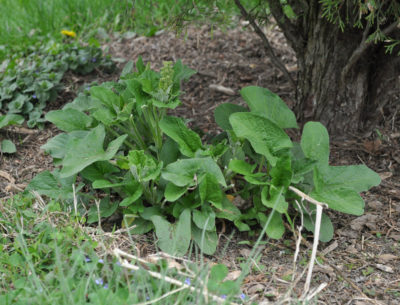
Whatever its name — and it’s also paraded under such common names as poor man’s asparagus and Lincolnshire spinach — Good King Henry is a vegetable that’s been eaten for hundreds of years, except hardly ever nowadays. While spinach, beet, and some of its other kin have been improved by breeding and selection over the years, Good King Henry was neglected.
But the Good King, besides having good flavor, has a few things going for it lacking in spinach. It’s a perennial plant, it’s edible all season long, and it has no pests problems worth mentioning. This Mediterranean native made its way to my garden over 20 years ago, from seed I purchased and sowed. I haven’t had to replant it since then.
Which brings me to one possible downside of Good King Henry: It keeps trying to spread beyond the far corner of the garden where I originally planted it. Every spring I yank out errant plants, and eat them.
One of my favorite things about Good King Henry is its species name, bonus-henricus, making its whole botanical name Chenopodium bonus-henricus.
Another Perennial Oldie
Another perennial vegetable that I’ve enjoyed this spring is seakale (Crambe maritima), a relative of cabbage, broccoli, and kale. This also is an old-timey vegetable, one whose popularity peaked in the 18th century; Thomas Jefferson was a fan.
The origin of the name may trace to the leaves (kale-like) being pickled to bring aboard ships (the “sea” part of the name) to prevent scurvy.
Seakale, though perennial, does not spread. I started my plants from seed a few years ago, which is tricky only because the seeds have a low germination percentage. I’ve seen a few seedlings pop up a foot or so from the mother plant, which I welcome as an easy way to multiply my holdings.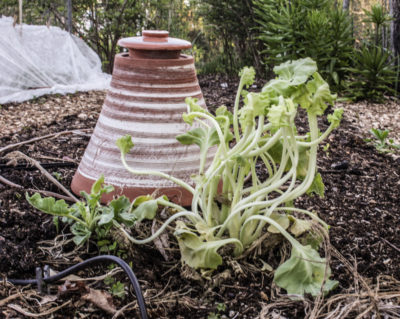
Seakale tastes very good either cooked or raw, something like a mild cabbage with a refreshing touch of bitterness. Either way, blanching is needed to make it tasty, and that entails nothing more than covering it for a couple weeks or so, more or less depending on the weather (more warmth, less time), to keep out light and make the shoots more mild and tender. I invert a clay flowerpot over the whole plant, with a stone or saucer over the drainage hole to keep light from wending its way in. Like asparagus, new leaves eventually need to be set free to bask in the sun to fuel the roots for the next year’s early shoots.
One more plus for seakale is that the plant is a beauty, so much so that it’s sometimes planted as an ornamental. The wavy, pale bluish green leaves have a silvery pallor reminiscent of the British seascape to which they are native. Later in the season, a seafoam of white blossoms rises from the whorl of leaves.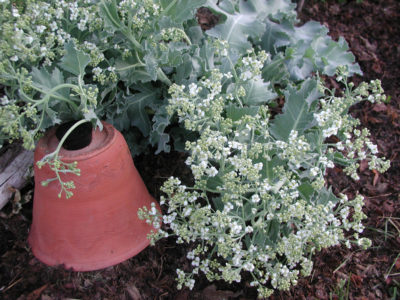
I Give Up
Now for an about face, from European plants enjoying cool weather and sometimes dry conditions, to a tropical American plant. Awhile back I wrote about my efforts to grow avocados here in New York’s Hudson Valley. Not on a large scale; just one or two plants from which I could harvest a few fruits of some special variety.
I grew two plants from seeds I saved from locally purchased avocado fruits, and grafted onto those seedlings the stems of two varieties a gardening buddy sent up from Florida. Ungrafted, the seedling plants would bear fruit of unknown quality, if they bore at all. Grafted plants would give me improved, named varieties that would bear quickly.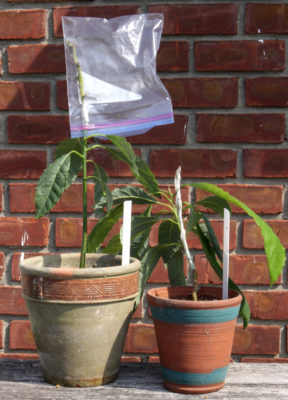

OLYMPUS DIGITAL CAMERA
I failed. Only one graft took, yet two varieties are needed for fruiting. As expected, the grafted stem on the successfully grafted plant flowered within a year of grafting. For days I tried to get the pollen from the male to pollinate the female parts of the flower — to no avail. And then, for some reason, the grafted stem started to darken and turn black, and died back.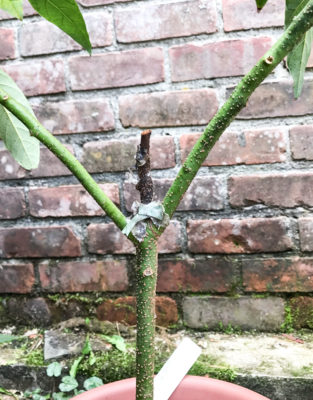
I give up on trying to grow an indoor-outdoor avocado plant — for fruit — in a pot.

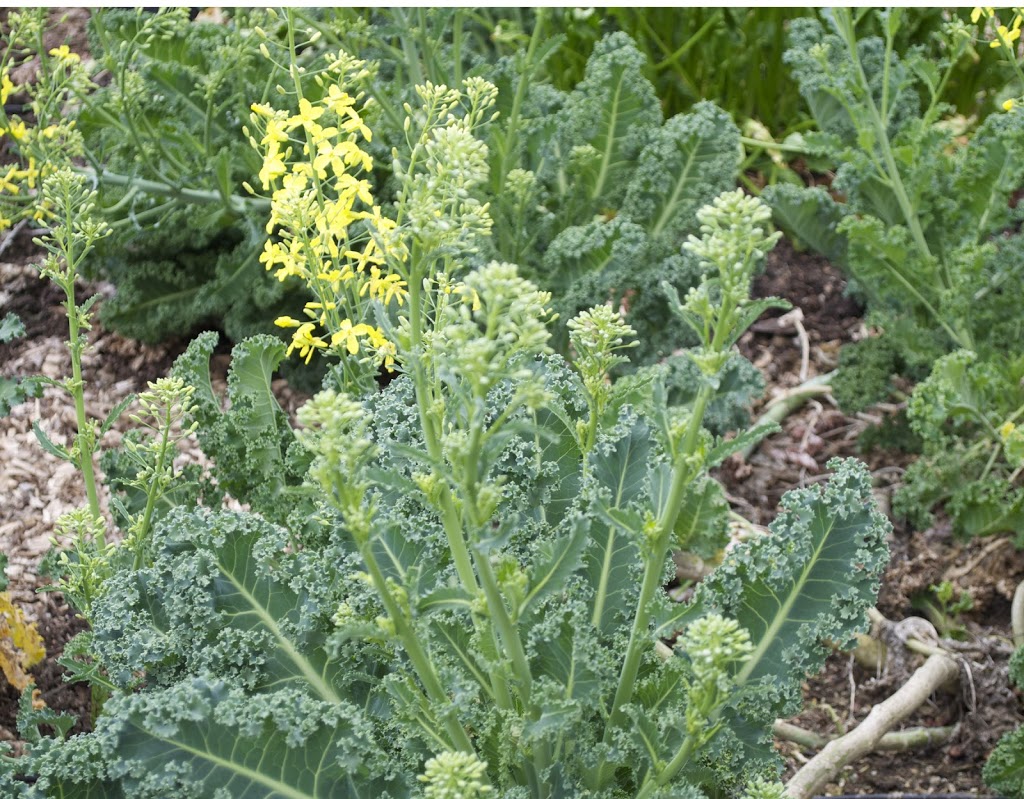

Hi Lee,
I’d love to see a whole article on perennial vegetables for this area with advice on where and how to best grow them. I have all your books, is there a chapter on this in one of them that I’ve missed?
Thanks for this one, very helpful. Would love to buy some seedlings of Good King Henry from you too if you can spare some from your table.
Thanks again,
Lena
No, I never had anything in any of my books on perennial vegetables. There is a whole book out on perennial (sort of) vegetables, with that title. Perhaps I’ll remember to have some plants of Good King Henry at my plant sale in spring.
Sorry about your avocado experiment – sometimes you need to know when to quit. And thanks for the heads up on Good King Henry. First time I have heard of it and keen to give a try.
I’m a big fan of try, try again in the garden, but sometimes it’s just not worth the effort. Our soil is alkaline so I planted blueberries in a specially prepared raised bed filled with peat moss and compost. But even with Sulfur applications, they were still pitiful and barely grew. So I’ve given up….for now.
It can be done. Blueberries are grown commercially in alkaline soils in California. Peat and sand would be better than peat and compost. You could line the beds to make sort of a pot in the ground and then fill with peat and sand, not compost. Or sink large pots into the ground and fill with that peat-sand mix. Check the alkalinity of your water also. Test your soil pH and make sure you add the correct amount of sulfur according to the pH. I think you should try, try again, once more, at least. Blueberries are worth it.
KUDOS for your effort!
Up in Alaska, we have excessive daylight hours for spinach so it bolts in a hearbeat. Is king henry light sensitive that way?
One green that works well here is claytonia or miners lettuce (from the gold rush era) and it will drop seed in the fall and so no need to plant the following spring.
The good thing about Good King Henry is that it tastes good even after it sends up a seedstalk. In fact, some people cook the seedstalks like asparagus. And, of course, it’s perennial.
Specially I liked that images very much. Specially Seakale one.
I’ve always heard avocado has perfect flowers, no need for two varieties. There are tpe A and type B plants. One opens male in the morning female in evening and the other does the opposite. Having one of each is optimum, but if you only have one you can brush the flowers in the morning and evening (or a bee could) of the same plant and it should work.
You’re right, and it does seem like hand pollination would work if you only had one plant. I’ve tried it more than once, without success. Not sure why.